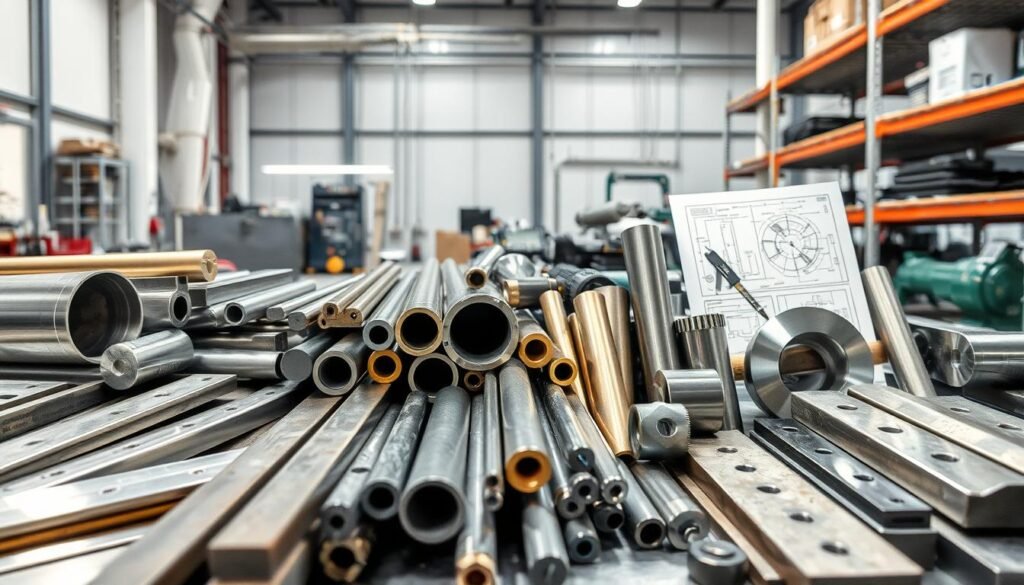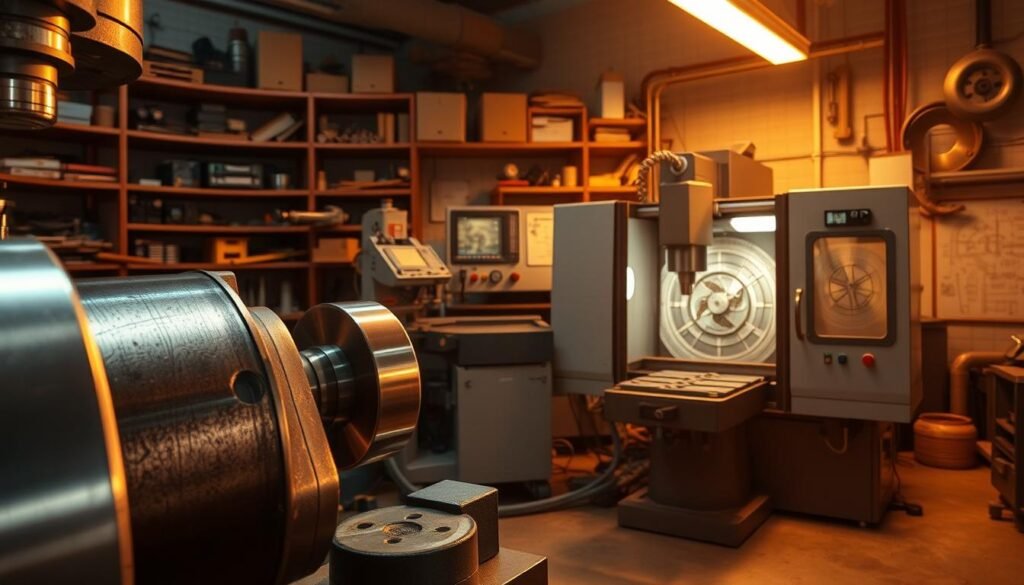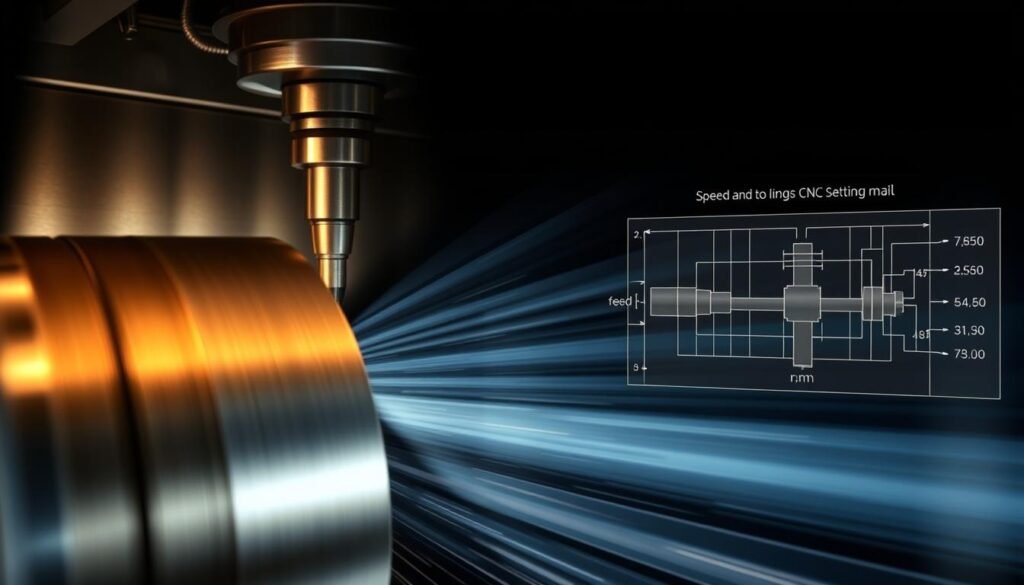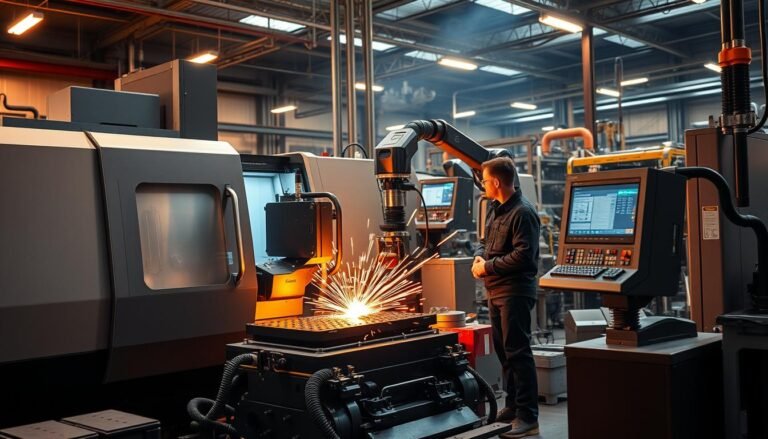Ever wondered what separates an average product from a great one in making things? In a world valuing precise making and speed, turning parts processing is key. CNC turning and metal shaping have changed the way we make precise, quality parts. But, how do these improvements help your business do better and more accurate work?
Here, we’ll dive into the key skills behind turning parts processing. We’ll look at how precise making and CNC tech play big roles in efficiency. We will also see how lathe work has gotten faster and more accurate, helping industries. By the end of this, you’ll see the benefits of knowing turning parts processing. It could give your business an edge in making metal parts.
Key Takeaways
- Learning the main skills of turning parts processing can make your parts much better.
- Precise making is crucial for top accuracy in making things.
- CNC turning tech makes the process smoother and cuts mistakes.
- New lathe techniques have greatly cut down on wait times.
- Being good at turning parts processing can put you ahead in the metal shaping game.
Understanding the Basics of Turning Parts Processing
In the component manufacturing world, turning parts processing is key. It’s a metalworking technique that shapes and sizes workpieces. A cutting tool trims material from a spinning piece. This shows our skill and commitment to top production standards.
What is Turning Parts Processing?
Turning involves different turning operations like facing, boring, and threading. Each one is important for making high-quality component manufacturing. They help us meet complex needs and follow strict production standards.
Importance of Precision in Turning Parts Processing
Dimensional accuracy is crucial in turning parts processing. It means parts last longer and work better. Keeping this accuracy is key for meeting industry standards. It makes manufacturing efficient and reliable.
Choosing the Right Materials for Turning Parts
Choosing the right material is key when making turned parts. Materials like aluminum, stainless steel, brass, and plastics have different properties. These properties affect how well they are made.
Common Materials Used in Turning
We use many materials for turning:
- Aluminum: It’s light and easy to shape. It’s found in planes, cars, and electronics.
- Stainless Steel: This material is strong and doesn’t rust. It’s used in medical tools, kitchens, and factories.
- Brass: Brass is easy to shape and used in pipes, electrical parts, and decorations.
- Plastics: PVC and nylon are flexible and light. They’re chosen for consumer goods and car parts.
Material Properties Impacting the Turning Process
It’s important to know about material properties for good machining. Consider:
- Hardness: This tells us about wear resistance and if it’s good for tough places.
- Ductility: It means the material can bend without breaking, which helps make surfaces smooth.
- Thermal Conductivity: This is about moving heat away while machining. It keeps tools and surfaces in good shape.
Finding the right balance between material strength and ease of shaping is a must. How well a material goes with cutting tools matters a lot. It influences wear resistance and how the surface looks at the end.

Essential Tools and Equipment for Turning Parts Processing
Choosing the right tools and equipment is key for turning parts. It’s all about getting precise results and making tools last longer. This helps make high-quality products efficiently.
Main Types of Turning Lathes

Different lathes serve different purposes. This knowledge is crucial for picking the right lathe.
- Center Lathes: Great for single items or small batches. They’re flexible and simple to use for many tasks.
- Turret Lathes: Best for making complex parts in large amounts. They have many tools that can be quickly changed.
- CNC Lathes: With great accuracy and consistency, these are vital for detailed parts.
Cutting Tools and Their Applications
The cutting tools you choose affect how well and fast you can turn parts. Here are some types:
- Carbide Inserts: They’re tough, fast, and great for hard materials and lots of work.
- High-Speed Steel (HSS) Tools: Flexible and cost-effective, perfect for various materials and smaller places.
- Cubic Boron Nitride (CBN) Tools: Best for hard materials. They last long and resist wear well.
Different shapes and coatings on inserts make them work better and last longer. Picking the best tools and equipment is crucial for top-notch parts. It must match the materials and goals of your project.
Techniques to Improve Accuracy and Precision
In precision engineering, high accuracy and precision are key. Using advanced manufacturing techniques helps reduce errors. Each step, like sharpening tools and calibrating machines, must be carefully done.
| Technique | Description | Impact |
|---|---|---|
| Regular Tool Sharpening | Ensures tools remain sharp and effective, reducing the likelihood of errors. | Enhanced precision and accuracy |
| Machine Calibration | Regular calibration aligns equipment with exact specifications. | Consistent quality control |
| Precision Measurement Tools | Utilizing high-accuracy instruments for precise measurements. | Reliable fine-tuning operations |
Expert machinists are crucial for accurate fine-tuning operations. They interpret blueprints and adjust things slightly. Their skill ensures consistent quality. Solid quality control measures check every step, making production excellent.

Optimizing Cutting Speeds and Feeds
To enhance machining and ensure top-notch cutting efficiency, we need to get cutting speeds and feeds just right. By choosing and tweaking these settings, we can greatly improve how our final product looks and performs. Let’s explore how to find these optimal settings and why they’re key in making things.
Determining Optimal Cutting Speeds
Picking the right cutting speeds depends on the material, tool, and how smooth you want the surface. To boost efficiency, we look at the workpiece’s thermal traits and hardness. For example, high-speed steel tools work best at slower speeds than carbide tools but still do a great job when finely adjusted.
- Material Properties: Different materials need different speeds. Aluminum works well at high speeds, but titanium is slower because it’s hard and reacts to heat.
- Tool Material: The tool’s material affects the cutting speed. Carbide tools can go faster than high-speed steel, making cutting more efficient.
- Desired Surface Finish: Want a smooth finish? You might need to slow down to lessen tool wear and make the surface better.
Adjusting Feed Rates for Quality Results
Adjusting feed rates helps balance cutting efficiency with how the surface turns out. By tweaking these rates, we control the part’s accuracy and how good it looks in the end. For example, slower feed rates often mean a nicer surface but could lower cutting speed.
- Impact on Tool Wear: Changing feed rates can cut down on tool wear, increase tool life, and keep cutting conditions ideal.
- Part Tolerance: Right feed adjustments mean parts meet tight standards, reducing redo work and boosting production quality.
- Surface Integrity: Managing feed rates right keeps the surface top-notch, essential for precise work.

In summary, the right management of cutting speeds and feeds is crucial for better machining, improved efficiency, and exceptional surfaces. Methodical optimization helps increase output and reduces tool wear, making manufacturing more efficient and cost-effective.
Coolant and Lubrication Strategies in Turning
Good coolant and lubrication methods are key for top turning outcomes. Metalworking fluids help control heat, so the workpiece and tool stay cool. This avoids shape changes and improves the surface.
Rightly using these fluids helps with chip removal. It lessens friction at the cut point. This removal of waste boosts how well machines work by keeping cuts consistent.
To keep coolant systems working well, we need to follow upkeep rules. Checking and keeping metalworking fluids at the right mix is crucial. This affects how long tools last and how they perform.
Using the right lubes also makes tools last longer and boosts work output. These methods reduce damage, allowing for more prolonged and better-quality production runs.
Here’s a detailed comparison for better clarity:
| Aspect | Impact |
|---|---|
| Thermal Management | Prevents thermal deformation, improving surface finish |
| Chip Removal | Ensures efficient debris clearance, enhancing productivity |
| Tool Longevity | Reduces wear, extending tool lifespan |
| Machining Productivity | Maintains optimal cutting conditions, increasing efficiency |
Safety Measures and Best Practices
Keeping workers safe is key when operating CNC machines. Companies must follow strict safety rules to avoid dangers and keep workers safe.
Personal Protective Equipment (PPE)
Workers need to wear the right safety gear to stay safe from CNC machine risks. Important safety gear includes:
- Safety Glasses: Protects eyes from flying chips and debris.
- Ear Protection: Shield ears from loud noise made by machines.
- Gloves: Safeguards hands from sharp edges and heat.
- Protective Clothing: Ensures coverage against coolants and lubricants.
Machine Safety Protocols
It’s vital to have strong safety rules for preventing accidents and staying safe. These rules include:
- Lockout/Tagout Procedures: Makes sure machines are off and cannot start by mistake during repairs.
- Machine Guarding: Physical barriers to stop accidental contact with moving parts.
- Regular Maintenance Checks: Finds and fixes possible dangers to keep conditions safe.
Following these safety steps and OSHA’s rules helps create a safe work area for everyone working with CNC machines. This careful planning greatly lowers the risks at work.
Troubleshooting Common Turning Problems
Turning parts often brings different challenges, needing a step-by-step way to solve issues quickly. It’s key to know why surface flaws and tool wear happen. This ensures precision in making things.
Identifying Surface Finish Issues
Surface problems in machined parts can come from wrong cutting settings, not the best tool choice, or bad machine settings. To fix these issues:
- Reviewing cutting speeds and feeds: Setting the right cutting speeds and feeds based on the material helps a lot.
- Inspecting tool condition: Keeping tools in good shape stops surface problems. Use new tools instead of dull or damaged ones for a better finish.
- Optimizing machine settings: Changing things like spindle speed and feed rate fixes surface issues, improving quality.
Dealing with Tool Wear
Tool wear is usual and affects how well and how efficiently turning is done. To handle tool wear:
- Implementing regular tool maintenance: Checking and caring for tools often stops too much wear and keeps performance up.
- Using high-quality cutting tools: Better tools mean fewer changes and more efficient work.
- Process optimization techniques: Using better methods makes tools last longer by reducing wear during turning.
To handle these machining problems, doing things step by step improves surface finish and tool life. This makes the turning process better.
Conclusion
As we wrap up our journey in mastering turning parts processing, it’s clear how important both basic and advanced knowledge is. Understanding the basics, choosing the right stuff, and making processes better is key. It’s all about being precise and improving all the time.
Technology plays a big role too. Keeping up with tech by training and getting new gear helps stay ahead. Better speed, feed, and cooling strategies boost efficiency, setting a high standard for success.
In short, sticking to these important tips is essential for doing well in turning parts processing. By always aiming for better and staying committed to improvement, businesses can boost their skills. This way, they can lead in their field.
FAQ
What is Turning Parts Processing?
Turning parts processing involves removing material from a workpiece. It shapes and sizes the piece while it spins. Activities like facing, boring, and threading are included. They help make diverse and complex parts.
Why is Precision Important in Turning Parts Processing?
Precision ensures parts meet standards and work as needed. It helps parts last longer and work better.
What Are the Common Materials Used in Turning?
We often use aluminum, stainless steel, brass, and plastics. These materials have unique features that affect turning. Hardness, ductility, and how they handle heat matter a lot.
How Do Material Properties Impact the Turning Process?
The process is impacted by how hard, stretchy, and heat-friendly materials are. Finding the right material balance is key. This also affects how well tools last and the finish on the surface.
What Are the Main Types of Turning Lathes?
There are center lathes, turret lathes, and CNC lathes. Each one fulfills different roles. They are built to make precise and efficient manufacturing possible.
What Cutting Tools Are Used and Their Applications?
The tools include carbide inserts, high-speed steel, and CBN tools. They vary by design and use. But all are important for tolerance, lifespan, and best performance with different materials.
What Techniques Improve Accuracy and Precision in Turning?
Better precision comes from sharpening tools, tuning machines, and using precise measurements. Experts must read plans carefully and adjust things slightly. This makes parts better and more consistent.
How Do You Determine Optimal Cutting Speeds?
Optimal speeds depend on the material, tool type, and the finish you want. The right speed improves cutting, part accuracy, and surface look.
How Should Feed Rates Be Adjusted for Quality Results?
Adjusting feed rates helps balance efficiency, accuracy, and surface quality. It’s about learning from real tasks. You also need to consider tool wear and how much you make.
How Important Are Coolant and Lubrication Strategies in Turning?
Coolant and lubrication keep things cool and smooth for better finishes. The right coolant flow helps remove chips and lessens friction. This makes tools last longer and improves work.
What Safety Measures and Best Practices Should Be Followed?
Safety includes wearing the right gear and sticking to machine safety rules. Regularly check and maintain machines. Following these guidelines keeps workplaces safe and accident-free.
How Can Common Turning Problems Be Troubleshooted?
For issues like poor surface finish or tool wear, check and maintain tools often. Use strategies to make manufacturing better overall.



